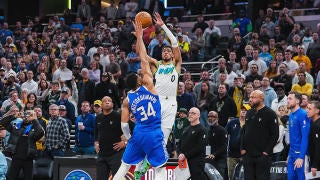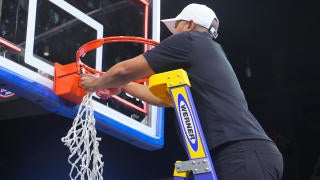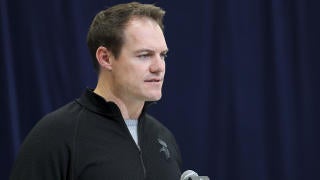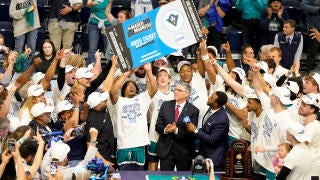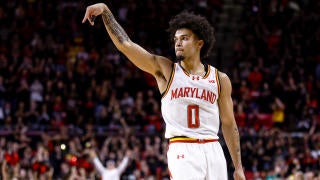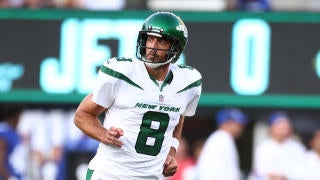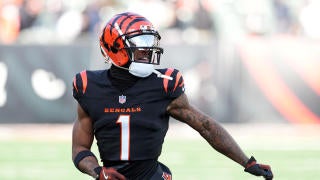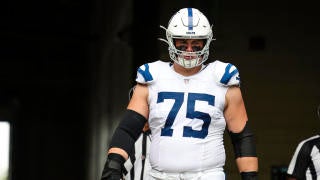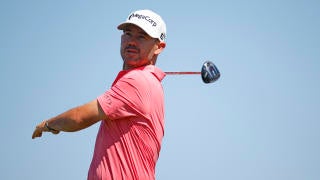BRISTOL, Tenn. -- After a 500-lap battle of attrition, Denny Hamlin held off Martin Truex Jr. to win the Food City 500 at Bristol Motor Speedway, earning his first victory of the 2024 season and his second-straight at Bristol. Hamlin came out on top in a race defined by tire management, managing his pace effectively enough to last until the end and hold off Truex in heavy lapped traffic.
After a number of cautions throughout the day -- most of which came at the end of the tires' life cycle due to extreme wear -- Hamlin and Truex settled in at the front of the field over the final green flag run, maintaining Joe Gibbs Racing's control over the race despite teammates Ty Gibbs and Christopher Bell falling by the wayside. Hamlin's win is the second in a row for Joe Gibbs Racing and for Toyota, following up on Bell's victory last weekend at Phoenix.
Food City 500 unofficial results
- #11 - Denny Hamlin
- #19 - Martin Truex Jr.
- #6 - Brad Keselowski
- #48 - Alex Bowman
- #5 - Kyle Larson
- #42 - John Hunter Nemechek
- #17 - Chris Buescher
- #9 - Chase Elliott
- #54 - Ty Gibbs
- #20 - Christopher Bell
On a day where tire wear created uncomfortable situations for many drivers in the field, Hamlin -- who grew up racing on abrasive short tracks throughout Southern Virginia -- found himself right in his comfort zone on his way to his 52nd career victory.
"That's what I grew up doing, here on the short tracks of the whole Mid-Atlantic. South Boston, Martinsville, all of those tracks -- It's just what I grew up doing," Hamlin told Fox Sports. "Once it became a tire management race, I really liked our chances. But obviously the veteran in Martin, he knew how to do it as well.
"We just had a great car, great team. The pit crew just did a phenomenal job all day, I can't say enough about them. ... Man, it feels so good to win at Bristol."
The variables in play turned Sunday's race at Bristol into a historic one. The lead changed hands a total of 54 times, setting a new NASCAR record for the most lead changes in any short track race in history. The 54 lead changes broke the track record of 40 set in spring 1991, and a mark of 16 different leaders tied the track record from the spring of 1989.
Sunday's race also marked the first time in 20 years that only five cars or less finished on the lead lap. Prior to Sunday, the last Cup Series race to feature that few cars on the lead lap came in June 2004, when Mark Martin won a race at Dover that also saw just five cars finish on the lead lap.
Worn out and wild
Prior to the green flag Sunday, there was a feeling that tire wear and tire management could play a factor in determining who would run up front and who would have the sustained speed to last over the course of a run. What no one predicted, however, was exactly how much tire wear there would be and how drastically it would alter the course of the day's 500 laps.
From the first run onward, each green flag run featured extreme tire wear and falloff, resulting in drivers having to back off dramatically in order to keep from burning the set of tires they had off and forcing them to pit for fresh tires at every possible opportunity. Although both the left and right side tire compounds were the same ones used in last September's Bristol Night Race, the application of a resin compound as opposed to PJ1 traction compound in the lower lane changed the way the tires reacted, creating much more extreme wear than Goodyear had anticipated as the track did not take rubber.
The importance of fresh tires was illustrated writ large on the first restart of the day, as it took just one lap for Tyler Reddick to get swallowed up and spun in front of traffic after staying out on old tires to take the lead.
"We tested here last year with the intent to come up with a tire package that generated more tire wear. That was the request from NASCAR and the teams. And we feel like we had a very successful test, we feel like we had a very successful race in the fall of last year," Goodyear's Greg Stucker told reporters mid-race. "... Now, we're trying to understand what's different, why the racetrack is behaving differently this weekend than what it did a year ago. It's the same package, it's the same tire combination. Obviously the difference is resin was placed on the lower groove instead of the PJ1. Yet I still think the racetrack should be taking rubber as it did last fall. It took rubber immediately during that race."
A myriad of drivers -- including Hamlin himself -- had tires wear down to the chords, with some tires even going down and sending drivers either spinning or toward the wall. That greatly influenced the pace of the race, as drivers progressively adapted and found themselves backing their pace down as runs went on in order to save their tires.
That led to some striking visuals, as several runs saw multiple cars close together and stacked on top of one another at the front of the field as the savviest of the frontrunners were content to let other drivers take the lead and be the "rabbit" setting the pace for everyone else. Hamlin ended up leading the most laps with 163, with Joe Gibbs Racing teammates Ty Gibbs (137) and Martin Truex Jr. (54) the only other drivers to lead more than 50 laps on the day.
As the field was forced to adapt, NASCAR and Goodyear were also put in a position where they needed to improvise. After the first half the race saw the field be on pace to burn through their 11 allotted sets of sticker tires, Goodyear worked to provide the entire field with an additional set of fresh tires to alleviate such concerns. That came in handy, as nine cautions on the day created just as many opportunities to come to pit road and put on fresh tires.
Lapped traffic was also a factor on the day, particularly during the final green flag run as a cycle of green flag pit stops developed and drivers on fresh tires had an extreme advantage in speed over cars on worn tires. After one close call navigating lapped traffic occurred when Ricky Stenhouse Jr. and Austin Cindric spun out right in front of Hamlin and Gibbs, the race for the win ultimately unfolded as Hamlin and Truex had to find the most efficient route through heavy lapped traffic.
Overall, the eventful and at times chaotic nature of Sunday's race made for a marked departure from the at-times maligned nature of Cup racing on short tracks since the Next Gen car proved to be poorly optimized for smaller ovals. The nature of the race was well received by the drivers in particular, as several referenced it hearkening back to their formative days racing on short tracks on their way up to NASCAR's highest level.
"You go to any of these local short tracks, that's how you have to race. Have take care of your stuff," Brad Keselowski told Fox Sports. "It's refreshing. It's different. I like that, that it takes something different every week. That's what makes Cup so hard. You go in every week, some weeks you drive 'em till you burn 'em down, this week you got to take care of 'em. It was fun."
"That was something I excelled at, and I feel like I was able to apply that today," Alex Bowman said, referencing his experience racing in ARCA over a decade ago. "In the Cup Series, we run hard every single lap all race these days. Kind of fun to go back to that. Maybe too far back to that. But glad we ended up on the right end of it."
Race results rundown
- While the Joe Gibbs Racing Toyotas maintained a strong presence at the front of the field, John Hunter Nemechek spent much of the day showing off the pace to match them in his Legacy Motor Club Toyota. Nemechek ran well up inside the top five at certain points before finishing sixth, improving his career-best Cup finish for the second time this season.
- There were times where it looked as though Sunday would be Ty Gibbs' day to earn his first career win, as he boasted arguably the fastest car in the field and proved to have extremely quick pace on multiple occasions. Worn tires would spoil Gibbs' chances of victory, but he would set a new career-high mark for laps led in a single race (137) on his way to finishing ninth.
- Also setting a new career-high for laps led in a single race was Hendersonville, Tenn.'s Josh Berry, who led twice for 25 laps after starting from the outside pole. Despite a mid-race spin, Berry would cycle into the top five following green flag pit stops and parlayed his extensive short track experience into a season-best 12th place finish. Berry was one of three Stewart-Haas Racing cars to finish in the top 15 along with Chase Briscoe in 13th and Ryan Preece in 14th.
- Both of the Rick Ware Racing cars had strong runs, with Justin Haley and Kaz Grala both making their way into the top 10 at certain portions of the race and staying there. Haley would finish 17th and Grala would finish 19th, with Haley's run marking his best finish of the season so far.
- While he ran up front early and even led five laps, Kyle Busch had yet another rough day on a short track as he dealt with tire issues and spun multiple times during the day. Busch would wind up finishing two laps down in 25th, marking his third-straight finish outside the top 20 after pit road issues at Las Vegas and poor overall performance at Phoenix.
- Despite the nature of the race, the attrition rate was fairly low: 35 of the 36 cars that started the race were running at the finish, with Zane Smith being the lone exception after an early crash and a blown tire gave way to engine issues that sidelined him after 192 laps. Smith's DNF is his second in what's turned into a rough start to his rookie year in Cup.
Next race
The NASCAR Cup Series goes from short track racing to its first road course race of the season, the Echopark Texas Grand Prix at Circuit of the Americas, next Sunday at 3:30 p.m. ET on Fox.
![[object Object] Logo](https://sportshub.cbsistatic.com/i/2020/04/22/e9ceb731-8b3f-4c60-98fe-090ab66a2997/screen-shot-2020-04-22-at-11-04-56-am.png)


